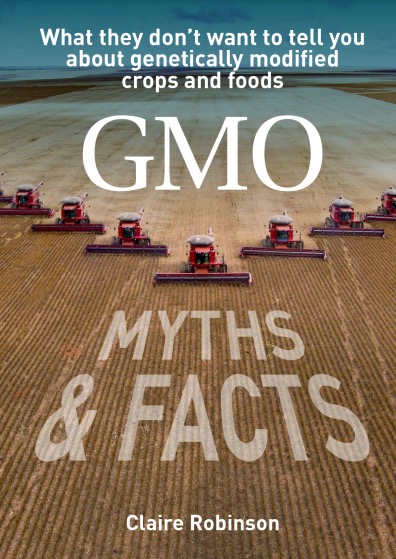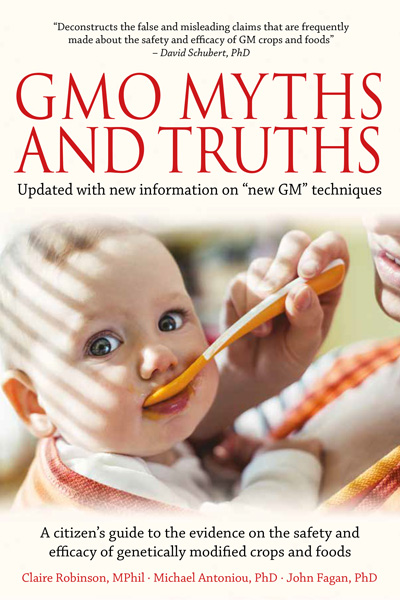 GM-fed monkeys showed indications of anaemia, kidney and thyroid disorders, and an altered gut microbiome. Report: Claire Robinson and Prof Michael Antoniou
GM-fed monkeys showed indications of anaemia, kidney and thyroid disorders, and an altered gut microbiome. Report: Claire Robinson and Prof Michael Antoniou
A long-term 7-year feeding study testing the effects of GM maize consumption across two generations of cynomolgus macaques – a type of monkey – was recently published in the journal Food and Chemical Toxicology. The GM maize tested contains two Bt insecticidal toxins and a gene conferring tolerance to glyphosate herbicide. The authors concluded that there are no adverse effects on the test animals or their offspring – even though some of their findings raise serious safety questions.
In a similarly reassuring vein, a recent article in European Scientist by surgeon Guy-André Pelouze heralds the study as “A 7 years analysis to end emotional era on GMOs”. The article criticises the “fear” surrounding GM foods in the 1990s, in particular pointing to the publicity that surrounded the publication of the Séralini study, which found liver and kidney diseases in rats fed a commercialised herbicide-tolerant GM maize over a long-term period of 2 years.
Pelouze believes the Séralini study to be “poorly controlled” and states that no conclusions on cancer and mortality rates can be drawn from it. However, these judgements are based on the incorrect presumption that it was a badly designed carcinogenicity study, when in fact, as the authors clearly state, it was designed as a toxicity study. Toxicity studies require a different design, with which the Séralini study conforms.
In contrast with his judgement on the Séralini study, Pelouze says the macaque study is “brilliant” and “should shift the debate on GMOs”, though he laments the “deafening silence” that greeted its publication. Clearly, through his article, he intends to put that right and awaken the public attention that he thinks the study deserves.
But is the macaque study really so reassuring about GMO safety? A closer analysis suggests not. The GM maize diet caused some adverse and potentially adverse changes in the macaques' health that need further investigation. These include indications of anaemia, kidney and thyroid disorders, and an altered gut microbiome.
Strengths of the study
As Pelouze notes, the study has important strengths:
* The animal model is widely viewed by scientists as highly human-relevant, in that health effects seen in monkeys are expected to translate to humans.
* The study followed two generations, called F0 and F1, over 7 years, which is rare for GM food studies.
* Three groups were fed differently: CK (standard feed), Corn (70% non-GM maize), and Tg (70% GM maize). This enabled comparison between the GM maize diets and the non-GM maize and standard diets.
* The GM and non-GM maize were grown at the same time under the same conditions, meaning any differences seen in the GM- and non-GM maize-fed groups are due to the genetic modification and not to different environmental growing conditions.
* Detailed compositional molecular analyses using up-to-date methods were carried out: metagenomics (on gut microbiota) and metabolomics (on faecal metabolites). In addition, important components of blood (including hormone levels) and urine were measured.
Major weaknesses of the study
Despite its strengths, the study has crucial shortcomings:
1) The GM maize was not sprayed with glyphosate herbicide during cultivation, meaning it does not reflect real-life conditions – and the actual effects of consuming GM maize that has been sprayed might have been worse than appears from these results. Spraying with glyphosate herbicide has been shown in a separate study to change the composition of a herbicide-tolerant GM maize, potentially altering its safety profile.
2) The number of animals (3 groups of 12 animals, 36 in all) was small, meaning that an effect found in only one or a few animals could be due to chance; and conversely, a real effect of GM maize feeding may be missed because the number of animals is too few to reliably show it. In sum, this study is statistically weak.
3) The selection process is in question. It’s fair to ask exactly how the 52 animals in the F1 generation were reduced to 30 for the remaining part of the experiment. On one hand, a selection process is needed because the monkeys would have given birth to offspring at different times and they would have different starting weights. It’s not possible to run an experiment that is staggered in time – it would be inefficient and would add another variable – all groups need to be run in parallel at the same time. So the researchers have to select in order to match the animals for age and pregnancy status, as they state. While they don’t mention matching them for weight, the beginning weights have to be within a limited range.
However, the important question is whether any selection took place based on health-related reasons, such as premature births, or underweight or unhealthy offspring. If so, we need to know the rates of these in the different groups, e.g. were they higher or lower in the GM group compared to the non-GM group? If no health-related factors were in play, the authors should say as much, and conversely, if they had to select out any animals for health-related reasons, they should state as much.
4) Any sex-related differences were ignored. The authors do not mention how many males vs females there were in the different groups of F0 or F1 generations. And crucially, they do not distinguish between males and females in the measurements, meaning any sex-dependent changes from the GM feed were obscured and also the “confounding factors” background noise created by any sex differences in response to the GM feed would further minimise the chances of seeing any GM feed-related effects that are sex-dependent.
Even though the authors do not state this, the F0 generation would have been predominantly female, since they started with 6 males and 30 females for mating. However, for the F1 generation, this sex imbalance does not apply, since we would expect roughly 50% males and 50% females to be born. So there is no excuse for the authors not to provide details of the sex balance in their F1 experimental groups.
In spite of these weaknesses, which make it harder to see any GM diet-related changes, worrying effects were still found in the macaques that were fed the GM maize diet, as described below.
* Possible thyroid problems
Hormone test results proved that three animals in the GM maize-fed group had higher than average T3 (a crucial thyroid hormone that regulates metabolism, growth, development, body temperature, and heart rate) concentrations. However, the authors found no abnormal levels in other thyroid hormones (TSH, T4, FT3, and FT4), so they dismiss this finding.
What the authors don’t say is that elevated T3 levels with normal levels of T4 can indicate a type of hyperthyroidism called T3 toxicosis.
In addition, the authors found that levels of FT3 – the amount of T3 not attached to transport proteins – were higher in a separate subset of GM maize-fed animals (supplementary data, Fig. S2) compared with non-GM-fed animals. However, these animals showed no abnormalities in other thyroid hormone measurements, so again, the authors dismissed the finding. That's a problem, because high FT3 levels with normal FT4 levels can be another indicator of hyperthyroidism.
In both the above cases, a single measurement that is beyond what's normal can be an indicator of serious disease. Such findings should not be dismissed, but flagged up as potential safety issues.
* Indications of anaemia
Blood biochemistry tests showed that in the F0 and F1 generations, the GM maize-fed group exhibited a significant decrease in mean corpuscular haemoglobin concentration (MCHC) and platelet count (PLT) compared to the non-GM maize and standard diet groups.
MCHC reflects the haemoglobin concentration within red blood cells, and its decrease is typically associated with hypochromic anaemia, a condition where red blood cells are paler than normal. However, in this study, the authors state that the MCHC decrease in the GM maize-fed group occurred only in the F1 generation, with a relatively small decrease compared to the non-GM maize and standard diet groups.
It's hard to believe that scientists could dismiss a statistically significant adverse effect, however "small" it may seem. As the renowned GM food safety researcher Dr Arpad Pusztai once told us, “small” has no meaning in scientific terms. An effect is either statistically significant or it isn't, and its size is no reason to dismiss it.
Equally hard to swallow is the authors’ implication that just because an adverse effect was only seen in the second (F1) generation of GM-fed macaques, it can be dismissed. By analogy, as we’re encouraged to see this study as relevant to humans, would we be reassured if an illness caused by our diet would “only” affect our children?
Regarding the PLT decrease, the authors acknowledge that this may increase bleeding risk. What they don’t say is that it can be a warning sign of serious diseases, including aplastic anaemia, autoimmune disease, or blood cancers.
Nevertheless, the authors reassure themselves about the PLT decrease in the GM maize-fed group, saying that as with the MCHC decrease, it was observed “only” in the F1 generation, and no abnormalities were detected in other platelet-related indicators.
However, they do pay lip service to the possibility that this finding may indicate that the GM maize may be toxic, conceding: “Whether the PLT decrease is attributable to the toxicity of GM maize requires further investigation.” We might ask them at this point what else could possibly have caused it, as they controlled for other factors – and the controls in place in this study are one of the strengths that Pelouze praises.
* Kidney damage and dysfunction
In urine tests, the F0 generation GM maize-fed group had dramatically increased levels of blood urea nitrogen (BLD), almost twice the level of the non-GM maize-fed group. This can indicate kidney dysfunction or disease.
One GM maize-fed animal of the F1 generation had a higher level of protein in its urine than animals in all other groups. This condition, known as proteinuria, indicates that the kidneys are not filtering blood properly and is often a sign of kidney damage. However, due to the low number of animals in the study and the single affected animal, this finding could be due to chance.
The F0 generation GM maize-fed group had higher levels of white blood cells (WBC) in their urine than the non-GM maize-fed group and the group fed a standard diet. Levels in the GM maize-fed group were nearly double those of the non-GM maize-fed group. This condition, known as pyuria, commonly indicates an infection or inflammation in the urinary tract. High WBCs can also signal other conditions such as kidney stones.
It's strange, then, that the authors comment: “The results indicate that feeding GM maize does not have a significant negative impact on clinical indicators.”
* High cholesterol
In blood tests on the F0 generation of animals, levels of cholesterol and the so-called “bad” cholesterol LDL-C were significantly higher than in the non-GM maize-fed animals. An increase was also seen in the F1 generation of GM-fed animals compared with the non-GM maize-fed animals, though this was not statistically significant.
High levels of these indicators are widely thought to contribute to atherosclerosis, or hardening of the arteries, raising the risk of heart attack or stroke.
* Metabolomics analyses raise questions about gut effects
Metabolic pathways constitute the basic biochemistry that provide cells with the energy and essential building blocks needed to function, survive, and grow. To assess the effects of GM maize consumption on metabolic pathways in the macaques’ gut microbiome, the authors collected faecal samples and analysed the metabolites in the faeces.
The findings revealed that GM maize consumption led to a significant increase in the faecal levels of certain metabolites. The authors don’t offer an explanation, but this finding shows at the very least that the GM maize is not substantially equivalent to the non-GM parent maize. Regulatory authorisations of GMOs are granted on the assumption that the GM plant is substantially equivalent to its non-GM counterpart. Clearly that assumption is false.
In addition, the GM-fed macaques had higher levels of vitamin B6 in their faeces. The authors note that this “may reflect excessive dietary intake of vitamin B6 or increased excretion due to absorption disorders. However, whether GM maize consumption can lead to vitamin B6 absorption disorders requires further evaluation.”
Also, in F0 and F1 generations, five metabolites that play a role in sugar metabolism of plants were identified in the faeces of macaques fed the standard diet or the GM maize, but were not detected in the faeces of macaques fed the non-GM maize. The authors comment: “The intestinal metabolite profiles observed in the GM maize-fed group may be attributed to the GM components (such as exogenous [foreign] proteins or secondary metabolites) influencing microbial communities and host-microbe interactions. These interactions could alter microbial metabolic activities.”
By this statement, the authors appear to indicate that the GM process has altered the composition of the maize – further proof that that the GM and non-GM maize are not substantially equivalent. What is required here is a proteomics (protein profiling) and metabolomics (biochemical profiling) of the GM and non-GM maize to provide an in-depth compositional analysis, to see whether the authors are correct about the source of the gut metabolite differences observed in the GM-fed group.
More generally, if the GM process has caused compositional changes on the level of proteins and metabolites (as has been observed before with a glyphosate-tolerant GM maize), these changes could include the production of toxins that could explain the potentially adverse outcomes seen in this study – for example, in thyroid and blood function.
The authors report that the results indicated that the consumption of GM maize had “no adverse effects on the microbial composition or community structure, although the concentrations of certain metabolites associated with carbohydrate metabolism were significantly reduced.” There is an obvious problem with the claim of “no adverse effects”, as changes in microbiota populations are difficult to interpret. And, in a statement that appears to contradict their claim of no adverse effects, the authors go on to conclude that “the consumption of GM maize does affect the gut microbiota and metabolite concentrations”, but add, “whether this poses a risk to the health and safety of cynomolgus macaques requires further verification”. The authors seem to have abandoned logic in an attempt to exonerate GM maize from any suspicion of causing harm.
The fact that the GM maize feed brought about significant changes in both microbiota populations and metabolic (biochemical) function compared to the non-GM shows that the two are not substantially equivalent. The authors do not analyse their health implications, because current science lacks the knowledge to allow this. They remain unknown.
Invalid use of control groups
The authors dismiss changes in the blood and urine of GM maize-fed animals if “only one control group presented significant differences”. However, this is not scientifically valid and seems to be an example of making up the rules as one goes along, again, to try to give GM maize a free pass.
The most important control group in this study is the non-GM maize-fed group, because any differences between this group and the GM maize-fed group will be due to the genetic engineering of the maize. Whether or not there are unintended differences in the GM maize, compared with its non-GM parent, due to the genetic engineering process is the crucial food safety question about GM crops and the one that regulators are attempting to answer in evaluating the safety of a GM food.
Above, we have done the authors’ work for them and drawn due attention to changes in the GM maize-fed animals compared with the non-GM maize-fed animals, as these reveal effects resulting from the GM transformation processes applied to the maize.
Overall conclusion fudges the findings
The authors’ overall conclusion is that “Although there were some statistically significant differences between the GM and non-GM groups, these differences did not disrupt biological functions during the feeding period.”
Given the above analysis of the findings, this conclusion doesn’t make sense. Biological functions were clearly disrupted – the measurements speak for themselves. It’s true that none of the GM-fed macaques keeled over and died, but they showed indications of anaemia, thyroid dysfunction, kidney dysfunction, high cholesterol, and altered gut microbiota and metabolites.
By Pelouze’s logic, we are not allowed to feel “emotional” about these findings or to “fear” GMOs. He seems to believe that we should welcome a heightened risk of certain diseases in ourselves or our families in return for the privilege of eating GM maize in a state of blissful obliviousness.
A final note to the unconvinced
For those who are not persuaded by this study that GMOs can be toxic, the GMO Research Database contains over 2,500 studies, surveys, and analyses that suggest various adverse impacts and potential adverse impacts of genetically engineered crops, foods and related pesticides. It has not been updated for some time so more studies will have accumulated since. Are we feeling reassured yet?
UPDATE: Points 3) and 4) under "Major weaknesses of the study" were added to this article on 25 Sept 2025. We thank those who drew the relevant questions to our attention.
Image: Shutterstock (licensed purchase)










